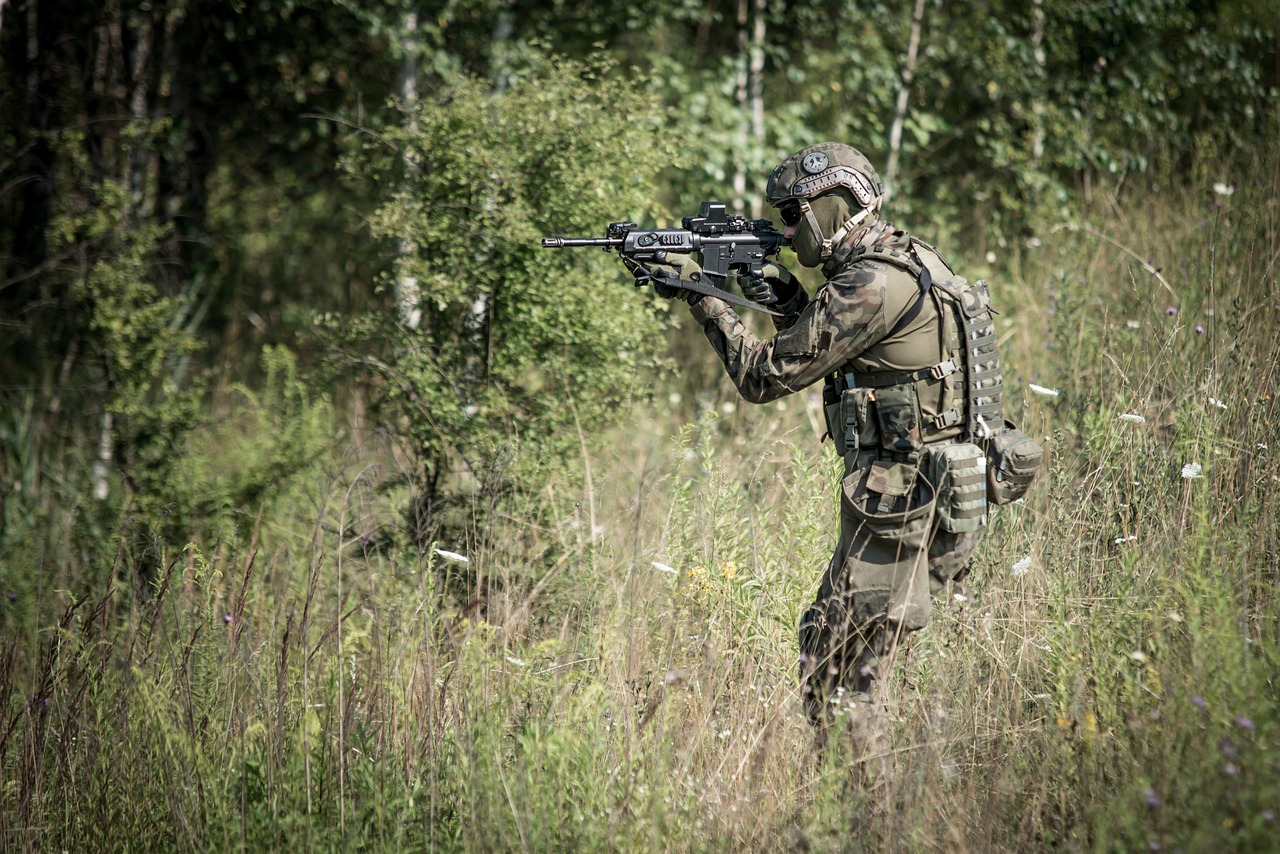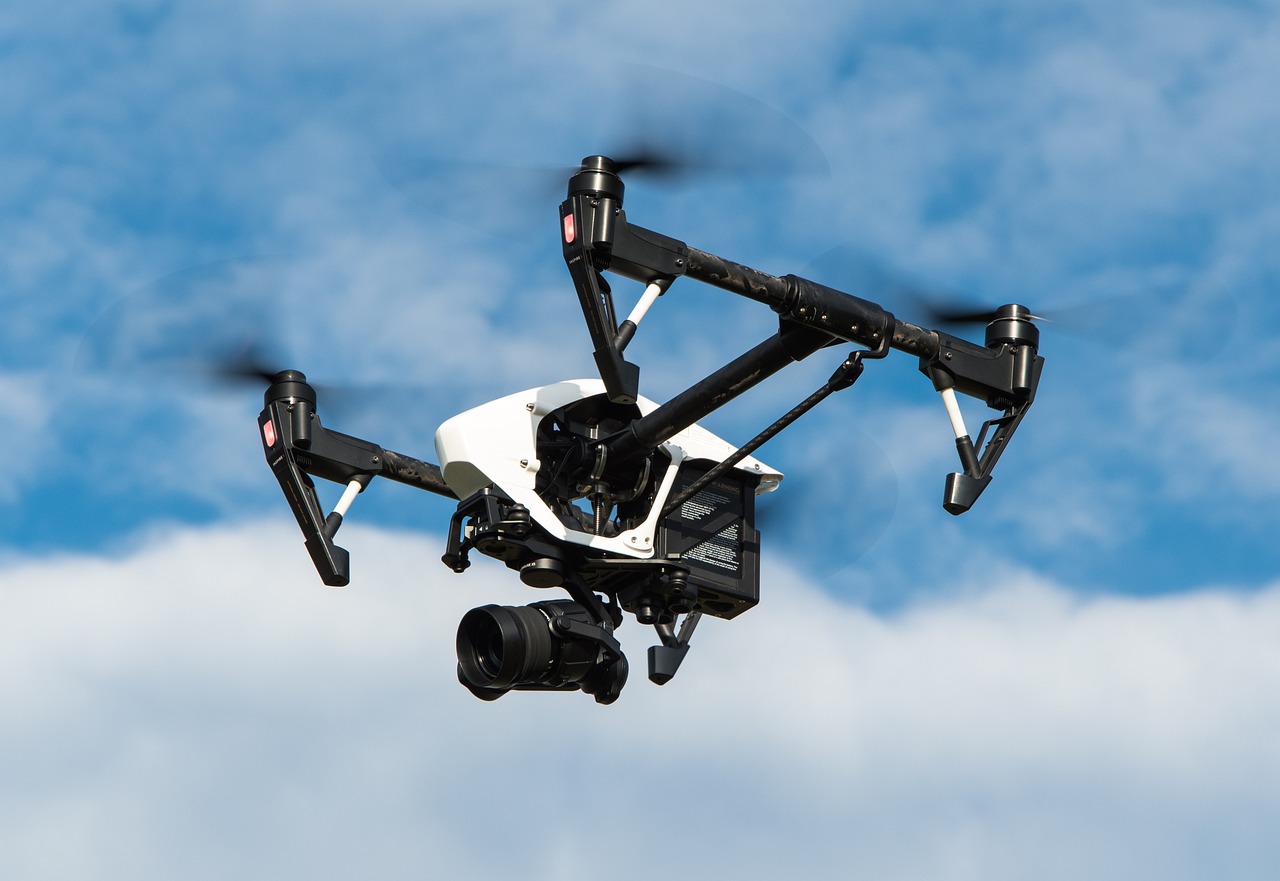AI-Assisted Soldier Load-Bearing Systems
This article explores the integration of AI technology in load-bearing systems for soldiers, enhancing their operational efficiency, comfort, and safety on the battlefield. As modern warfare evolves, the demands on soldiers intensify, requiring not only physical strength but also innovative solutions to support their missions. Enter AI-assisted load-bearing systems, a game-changing technology that promises to revolutionize how soldiers carry their gear and navigate challenging environments.
Imagine a soldier equipped with a load-bearing system that adapts to their movements, optimizes weight distribution, and monitors fatigue levels in real-time. This is not science fiction; it's the future of military operations. The traditional load-bearing systems, while functional, often fall short in providing the necessary support and adaptability needed in dynamic combat situations. With AI at the helm, these systems are being redefined to meet the rigorous demands of today’s battlefield.
At its core, AI-assisted load-bearing technology integrates advanced algorithms and data analytics to create a more intuitive and responsive experience for soldiers. By analyzing various parameters such as terrain, mission type, and individual soldier characteristics, these systems can adjust their functionality to ensure maximum efficiency and comfort. This means that soldiers can focus on their primary objective—completing their mission—without being weighed down by cumbersome gear.
But how does this actually work? Well, think of it like a smart backpack. Just as a smart backpack can sense when it's too heavy and redistribute weight, AI-assisted systems can dynamically alter the load based on real-time data. This not only enhances mobility but also significantly reduces the risk of injury caused by improper weight distribution. With these systems, soldiers can carry heavier loads without the accompanying fatigue, allowing them to operate at peak performance for longer periods.
Moreover, the integration of AI goes beyond just comfort and efficiency. It also plays a crucial role in safety. By continuously monitoring the soldier's performance and the stress placed on their body, these systems can alert them to potential injuries before they become serious issues. Imagine being told that your gear is causing undue strain on your back before you even feel the pain—this proactive approach to soldier health could save lives and enhance operational readiness.
In summary, AI-assisted soldier load-bearing systems represent a significant leap forward in military technology. They not only enhance the physical capabilities of soldiers but also prioritize their well-being, making them an invaluable asset in the ever-evolving landscape of warfare. As we delve deeper into the specifics of these systems, we will explore their design improvements, real-time monitoring capabilities, and the exciting future trends that lie ahead.
- How do AI-assisted load-bearing systems improve soldier performance?
These systems optimize weight distribution, enhance comfort, and monitor fatigue levels, allowing soldiers to perform better during missions. - What are the safety benefits of integrating AI into load-bearing systems?
AI can alert soldiers to potential injuries by monitoring their performance and the stress on their bodies, enabling proactive health management. - Are there any challenges in implementing AI-assisted load-bearing systems?
Yes, there are technical limitations, logistical challenges, and ethical considerations that need to be addressed for successful integration. - What does the future hold for soldier load-bearing technology?
Emerging technologies and advancements in AI are expected to redefine soldier capabilities, making load-bearing systems even more efficient and effective.

Overview of Load-Bearing Systems
Load-bearing systems are the unsung heroes of military operations, offering vital support to soldiers as they traverse challenging terrains and engage in demanding missions. These systems have evolved significantly over the years, transitioning from basic backpacks to sophisticated, ergonomically designed gear that optimally distributes weight and enhances mobility. Imagine a soldier carrying a load that feels as light as a feather; this is the promise of modern load-bearing systems, which are meticulously engineered to balance functionality and comfort.
Historically, soldiers relied on simple canvas packs and leather belts to carry their gear. However, as warfare has progressed, so too has the technology behind these systems. Today’s load-bearing systems are crafted with advanced materials that not only reduce weight but also improve durability and weather resistance. The integration of features like adjustable straps, breathable fabrics, and modular components allows soldiers to customize their gear according to mission requirements. This adaptability is crucial, as it enables soldiers to carry everything from ammunition to medical supplies without sacrificing their agility or stamina.
Moreover, the importance of load-bearing systems cannot be overstated. In the heat of battle, every ounce counts. A well-designed system helps to minimize fatigue, allowing soldiers to focus on their mission rather than the burden of their gear. For instance, modern load-bearing systems often include:
- Weight Distribution: Technologies that distribute weight evenly across the body, reducing strain on the back and shoulders.
- Modularity: Components that can be added or removed based on mission needs, providing flexibility in load management.
- Comfort Features: Padded straps and back panels that enhance comfort during long periods of wear.
As we look to the future, the integration of artificial intelligence into load-bearing systems is set to revolutionize how these systems function. Imagine a system that not only adjusts to the soldier's body but also analyzes the environment and adapts accordingly. This synergy between human capability and technological advancement promises to enhance operational efficiency and safety on the battlefield.
In conclusion, load-bearing systems are essential for modern soldiers, evolving from simple designs to advanced, customizable solutions that enhance performance. As technology continues to advance, we can expect even more innovative developments that will further improve the soldier's experience, ensuring they are equipped to face the challenges of modern warfare.
- What are load-bearing systems? Load-bearing systems are gear designed to support soldiers in carrying equipment efficiently and comfortably during missions.
- How have load-bearing systems evolved? They have transitioned from basic designs to advanced systems that incorporate ergonomic features and modern materials for better performance.
- What role does AI play in load-bearing systems? AI enhances load-bearing systems by optimizing weight distribution, personalizing designs based on user data, and enabling real-time performance monitoring.
- Why is weight distribution important? Proper weight distribution minimizes fatigue and strain on the body, allowing soldiers to maintain agility and focus on their missions.

Role of AI in Load-Bearing Technology
Artificial Intelligence (AI) is revolutionizing the way we think about load-bearing systems for soldiers, transforming them from mere equipment into intelligent companions on the battlefield. Imagine a world where your gear doesn't just carry your supplies but also understands your needs, adjusts to your movements, and helps you perform at your best. This is not science fiction; it’s the reality that AI is creating in military technology.
One of the most significant ways AI enhances load-bearing technology is through data analysis. By collecting and analyzing vast amounts of data from soldiers' movements, stress levels, and even environmental conditions, AI can optimize the design and functionality of load-bearing systems. For instance, if a soldier is traversing rough terrain, the AI can adjust the weight distribution of the load to maintain balance and stability. This real-time adjustment means that soldiers can focus on their mission rather than struggling with cumbersome gear.
Moreover, AI-driven systems can personalize load-bearing solutions for individual soldiers. Each soldier has unique physical characteristics and operational needs, and AI algorithms can analyze this data to create tailored solutions. For example, consider a soldier who is shorter in stature. AI can recommend a load-bearing system that redistributes weight more effectively for their body type, enhancing comfort and efficiency. This personalized approach not only boosts performance but also minimizes the risk of injury, which is crucial in high-stakes environments.
As we dive deeper into the role of AI in load-bearing technology, it’s essential to highlight the concept of data-driven design improvements. AI algorithms can sift through mountains of data, identifying patterns and preferences that human designers might overlook. By understanding how soldiers interact with their gear, AI can suggest modifications that enhance usability and comfort. For example, if data shows that a certain strap design causes discomfort during prolonged use, AI can propose alternatives based on successful designs from other users.
Another remarkable feature of AI in load-bearing systems is its ability to conduct real-time performance monitoring. Imagine a scenario where a soldier's gear is equipped with sensors that continuously track their physical condition and the load they are carrying. This data can be relayed to a central command, allowing for immediate adjustments to be made if the soldier is at risk of overexertion or injury. This proactive approach not only enhances individual safety but also ensures that the entire unit remains operationally ready, which is vital in combat situations.
Adaptive load management is yet another breakthrough facilitated by AI. This technology allows load-bearing systems to adjust their weight distribution dynamically based on the terrain and mission requirements. For instance, if a soldier is moving from a flat surface to a steep incline, the system can redistribute the load to enhance mobility and reduce fatigue. This means that soldiers can operate more effectively in diverse environments, making them more agile and responsive to changing situations.
The integration of AI into load-bearing technology is not just about convenience; it's about empowering soldiers to perform at their peak. By leveraging data and real-time adjustments, AI is reshaping the battlefield experience, ensuring that soldiers are not only equipped but also supported in their missions. As we look to the future, the potential for AI to redefine load-bearing systems is limitless, paving the way for an era of enhanced operational efficiency and soldier safety.
- What are load-bearing systems? Load-bearing systems are equipment designed to help soldiers carry their gear more efficiently and comfortably.
- How does AI improve load-bearing technology? AI analyzes data to optimize design, monitor performance, and adapt load distribution in real-time.
- Can AI personalize load-bearing solutions for individual soldiers? Yes, AI can create tailored designs based on individual soldier data, enhancing comfort and efficiency.
- What is real-time performance monitoring? It refers to the continuous tracking of a soldier's physical condition and load, allowing for immediate adjustments to prevent injury.
- What is adaptive load management? This is a system where the load distribution adjusts dynamically based on the soldier's environment and mission needs.

Data-Driven Design Improvements
In the rapidly evolving landscape of military technology, are paving the way for a new era of load-bearing systems tailored specifically for soldiers. Imagine a world where the gear you wear is not just standard issue but customized to fit your unique needs and preferences. This is precisely what AI technology is bringing to the table. By harnessing the power of big data and advanced algorithms, military designers can now create load-bearing systems that adapt to the individual soldier’s physical characteristics and operational requirements.
So, how does this work in practice? Well, AI algorithms analyze a vast array of data collected from soldiers during training exercises and missions. This data can include metrics like body measurements, movement patterns, and even feedback on comfort levels. By processing this information, AI can identify trends and preferences, leading to the development of personalized designs that enhance both comfort and functionality. For example, if a soldier consistently reports discomfort in a particular area due to equipment weight distribution, the AI can suggest adjustments to the design that mitigate this issue.
Furthermore, these improvements are not just about comfort; they also translate to increased operational efficiency. A well-fitted load-bearing system can significantly reduce fatigue, allowing soldiers to focus on their mission rather than their gear. Consider this: a soldier who can move freely and comfortably is more likely to perform effectively in high-pressure situations. This is where the true value of data-driven design shines through.
To give you a clearer picture, let’s look at some potential benefits of AI-driven design improvements:
- Enhanced Comfort: Tailored designs reduce pressure points and improve overall wearability.
- Improved Performance: Soldiers can carry more gear without the associated fatigue, enhancing their operational capabilities.
- Injury Prevention: By analyzing stress points, AI can help in designing systems that minimize the risk of injuries.
The future of load-bearing systems is not just about making them lighter or more durable; it’s about creating an experience that integrates seamlessly with the soldier’s body and mission. As we continue to gather more data and refine our understanding of what soldiers need, the potential for innovation is limitless. Imagine a load-bearing system that not only adjusts to your physical form but also learns from your movements and habits, continuously evolving to meet the demands of diverse environments.
In conclusion, the integration of AI in designing load-bearing systems is not merely a technological upgrade; it represents a paradigm shift in how we approach soldier gear. As we move forward, it’s essential to keep pushing the boundaries of what’s possible, ensuring that our soldiers are equipped with the best tools available to keep them safe and effective on the battlefield.
- What are load-bearing systems?
Load-bearing systems are equipment designed to help soldiers carry essential gear, distributing weight to enhance comfort and mobility. - How does AI improve load-bearing systems?
AI analyzes data from soldiers to create personalized designs, optimizing comfort, weight distribution, and overall performance. - What are the benefits of data-driven design?
Benefits include enhanced comfort, improved performance, and reduced risk of injuries, allowing soldiers to operate more effectively. - Are there any challenges in implementing AI in military gear?
Yes, challenges include technical limitations, logistical issues, and ethical considerations related to decision-making and soldier safety.

Real-Time Performance Monitoring
In the fast-paced world of modern warfare, is becoming a game-changer for soldiers on the battlefield. Imagine being able to track your physical exertion, monitor your load stress, and receive immediate feedback on your performance—all while in the midst of a mission. This integration of AI technology into load-bearing systems is not just about convenience; it’s about enhancing soldier safety and operational readiness.
With the aid of sophisticated sensors embedded in load-bearing gear, soldiers can now gain insights into their physical condition and the stress their bodies are enduring. For instance, AI can analyze data such as heart rate, temperature, and muscle strain, providing crucial information that can help prevent injuries before they occur. This proactive approach to health monitoring is akin to having a personal coach who not only motivates you but also keeps a vigilant eye on your physical limits.
Furthermore, the implications of real-time monitoring extend beyond individual soldiers. Commanders can access aggregated data to assess the overall health and performance of their units. This kind of data-driven decision-making can lead to better mission planning and resource allocation. For example, if a particular squad is showing signs of fatigue or stress, commanders can adjust their mission parameters or provide additional support, ensuring that their troops remain effective and safe.
To illustrate the impact of real-time performance monitoring, consider the following table that outlines key metrics monitored by AI systems:
| Metric | Description | Importance |
|---|---|---|
| Heart Rate | Tracks the soldier's heart rate during operations. | Identifies stress levels and potential fatigue. |
| Load Stress | Measures the weight being carried and its distribution. | Assesses the risk of injury and fatigue. |
| Temperature | Monitors body temperature to detect overheating. | Prevents heat-related illnesses. |
| Movement Patterns | Analyzes gait and movement efficiency. | Improves mobility and reduces injury risk. |
This real-time feedback loop not only empowers soldiers but also promotes a culture of safety and accountability. When soldiers are aware of their physical status, they can make informed decisions, such as when to take a break or when to adjust their load. It’s like having a built-in warning system that alerts them before they push their limits too far.
However, the implementation of such advanced monitoring systems does come with its own set of challenges. Data privacy and the ethical use of personal health information are critical considerations. Soldiers must feel confident that their data is secure and used solely for their benefit. Striking this balance between technology and personal privacy will be essential as we move forward into a future where AI plays a central role in military operations.
In conclusion, represents a significant leap in how we approach soldier welfare on the battlefield. With the ability to monitor health metrics and adjust strategies accordingly, we are not just enhancing operational efficiency; we are fundamentally changing the way we think about soldier safety and performance. As technology continues to evolve, the potential for AI-assisted load-bearing systems in military applications will only grow, paving the way for a more resilient and capable fighting force.
- What is real-time performance monitoring in military applications?
Real-time performance monitoring involves tracking soldiers' health metrics, such as heart rate and load stress, during operations to enhance safety and operational effectiveness. - How does AI contribute to load-bearing systems?
AI optimizes load-bearing systems by analyzing data to improve design, weight distribution, and adaptability based on real-time conditions. - What are the benefits of monitoring soldiers' health metrics?
Monitoring health metrics helps prevent injuries, allows for informed decision-making, and promotes overall soldier welfare during missions. - Are there ethical concerns regarding data privacy?
Yes, the use of personal health data raises important ethical questions about privacy and the responsible use of this information in military contexts.

Adaptive Load Management
Adaptive load management is revolutionizing the way soldiers interact with their equipment on the battlefield. Imagine a scenario where a soldier is traversing rugged terrain, their gear shifting seamlessly to accommodate the challenges of the environment. This is not just a dream; it is becoming a reality through the integration of artificial intelligence (AI) in load-bearing systems. By utilizing real-time data, AI can dynamically adjust the weight distribution of a soldier's gear based on various factors, such as terrain type, mission requirements, and even the soldier's physical condition.
For instance, when moving uphill, the system can redistribute weight to reduce strain on the soldier's back and legs, enhancing their endurance and mobility. Conversely, when descending, the load can be shifted to maintain balance and stability. This adaptability is crucial, especially in high-stakes situations where every ounce of efficiency counts. The AI algorithms continuously learn from the soldier's movements and preferences, allowing for a highly personalized experience that can significantly reduce fatigue and improve overall performance.
Furthermore, the benefits of adaptive load management extend beyond just physical comfort. By optimizing load distribution, soldiers can maintain a higher level of operational readiness. This can be particularly vital during prolonged missions where every moment of energy conservation can mean the difference between success and failure. With AI's ability to predict and respond to the soldier's needs, the load-bearing system becomes a trusted ally rather than just a piece of equipment.
However, implementing adaptive load management does come with its challenges. The technology must be robust enough to withstand the rigors of military operations while remaining lightweight and unobtrusive. Additionally, soldiers need to be trained to understand and trust this technology, ensuring they can rely on it in critical moments. As we look to the future, the potential for AI-driven adaptive load management in soldier load-bearing systems is immense, paving the way for a new era of military efficiency and safety.
- What is adaptive load management? Adaptive load management refers to the use of AI technology to dynamically adjust the weight distribution of a soldier's gear based on real-time data, enhancing mobility and reducing fatigue.
- How does AI improve load-bearing systems? AI analyzes data to optimize design, monitor performance, and adapt load management, ensuring soldiers can operate effectively in various environments.
- What are the benefits of using AI in military applications? The benefits include enhanced operational efficiency, improved comfort, reduced risk of injury, and increased adaptability to changing mission requirements.
- Are there challenges in implementing AI in load-bearing systems? Yes, challenges include technical limitations, the need for robust hardware, and ethical considerations regarding soldier autonomy and safety.

Future Trends in Soldier Load-Bearing Systems
The future of soldier load-bearing systems is not just about carrying equipment; it's about revolutionizing the way soldiers operate on the battlefield. As technology continues to advance at an unprecedented pace, we can expect to see a plethora of innovations that will redefine the capabilities of our military personnel. Imagine a world where soldiers are equipped with smart fabrics that can monitor their vitals or exoskeletons that enhance physical strength and endurance. These developments are not mere fantasies; they are on the horizon and set to change the dynamics of warfare.
One of the most exciting prospects is the integration of wearable technology into load-bearing systems. This technology will allow soldiers to not only carry their gear but also receive real-time data on their performance and environment. For instance, a soldier could wear a vest that adjusts its weight based on the terrain they are traversing. If they are climbing a steep hill, the vest could redistribute the load to maintain balance and reduce strain on their body. This adaptability will be crucial in ensuring that soldiers remain agile and effective in diverse scenarios.
Moreover, the incorporation of artificial intelligence will play a pivotal role in optimizing load-bearing systems. AI algorithms will analyze vast amounts of data collected from various missions to identify patterns and improve designs. This could lead to the development of customized load-bearing solutions that cater to the unique needs of individual soldiers. Imagine a soldier who has a specific body type or who is engaged in a particular type of mission. AI could help create a load-bearing system that is tailored to their requirements, enhancing comfort and operational efficiency.
In addition to these advancements, we can also anticipate the rise of collaborative robots or cobots that assist soldiers in carrying heavy loads. These robots could work alongside soldiers, helping to transport equipment and supplies, thereby allowing soldiers to conserve their energy for critical tasks. The synergy between humans and machines could lead to a new era of operational effectiveness, where soldiers are supported by technology rather than hindered by it.
However, with these advancements come challenges that must be addressed. The implementation of these technologies will require significant investment in research and development, as well as training for soldiers to adapt to new systems. Additionally, there will be ethical considerations regarding the use of AI and robotics in combat situations. As we move forward, it is essential to strike a balance between leveraging technology for enhanced performance and maintaining the human element that is so vital in military operations.
In conclusion, the future trends in soldier load-bearing systems promise a transformative impact on military operations. With innovations like smart fabrics, AI-driven designs, and collaborative robots, soldiers will be better equipped to handle the demands of modern warfare. As we embrace these changes, we must also remain vigilant about the challenges they present, ensuring that technology serves to enhance, rather than complicate, the lives of those who serve.
- What are load-bearing systems?
Load-bearing systems are equipment designed to help soldiers carry their gear efficiently and comfortably, often including backpacks, vests, and harnesses. - How does AI improve load-bearing systems?
AI enhances load-bearing systems by analyzing data to optimize design, improve weight distribution, and provide real-time performance monitoring for soldiers. - What is the role of wearable technology in future soldier systems?
Wearable technology will enable soldiers to receive real-time data on their performance and adjust their load-bearing systems based on environmental conditions. - Are there ethical concerns with AI in military applications?
Yes, the use of AI in military contexts raises ethical questions about autonomy, decision-making, and the implications for soldier safety.

Challenges in Implementation
Integrating AI into load-bearing systems for soldiers presents a myriad of challenges that must be carefully navigated. While the potential benefits are enticing—enhanced operational efficiency, improved comfort, and greater safety—the road to successful implementation is fraught with obstacles. These challenges can be categorized into several key areas: technical limitations, logistical hurdles, and ethical considerations.
First and foremost, technical limitations are a significant barrier. Current hardware and software technologies often fall short of the demands required for real-time data processing and adaptive functionalities. For instance, the sensors and materials used in load-bearing systems must be lightweight yet durable, able to withstand the rigors of combat. However, many existing components are either too heavy or lack the necessary resilience. This creates a scenario where soldiers may be burdened by outdated technology that fails to meet modern warfare's dynamic requirements.
Logistical challenges also play a critical role in the implementation of AI-assisted systems. The military operates under strict procurement processes and budget constraints, which can delay the introduction of innovative technologies. Additionally, training personnel to effectively utilize these advanced systems is essential, yet often overlooked. Soldiers need to be well-versed in the technology to maximize its benefits; otherwise, the integration can lead to confusion and inefficiency on the battlefield. This training process can be both time-consuming and resource-intensive, further complicating deployment.
Moreover, the ethical considerations surrounding AI in military applications cannot be ignored. The use of AI raises profound questions about autonomy and decision-making. For example, if an AI system makes a recommendation regarding load distribution or mission strategy, who is ultimately responsible for that decision? This dilemma poses a moral quandary for military leadership, as they must weigh the benefits of AI against the potential risks to soldier safety and ethical standards. Ensuring that AI systems are designed with robust ethical frameworks is crucial to prevent misuse or unintended consequences.
In summary, while the integration of AI into soldier load-bearing systems holds tremendous promise, it is imperative to address the challenges of technical limitations, logistical hurdles, and ethical considerations. Only by confronting these issues head-on can we unlock the full potential of these advanced technologies and ensure that they serve to enhance, rather than hinder, soldier effectiveness on the battlefield.
- What are the primary challenges in implementing AI-assisted load-bearing systems?
The main challenges include technical limitations, logistical hurdles, and ethical considerations that must be addressed for effective integration. - How does AI improve load-bearing systems for soldiers?
AI enhances load-bearing systems by optimizing weight distribution, personalizing designs based on user data, and providing real-time performance monitoring. - What ethical concerns arise from using AI in military applications?
Ethical concerns include questions about autonomy in decision-making, accountability for AI-generated recommendations, and the moral responsibilities of military leadership. - Are there any current technological constraints affecting AI deployment?
Yes, existing hardware may be too heavy or not resilient enough, and software may lack the capabilities needed for real-time data processing.

Technical Limitations
As we dive into the realm of AI-assisted soldier load-bearing systems, it's essential to confront the that currently challenge their implementation. While the potential benefits of integrating AI into military gear are immense, several hurdles remain that could impede progress. For starters, the hardware used in these systems often struggles to keep pace with the sophisticated algorithms developed for AI. Imagine trying to run the latest video game on a decade-old computer; the experience is bound to be disappointing. Similarly, outdated sensors and processing units can limit the effectiveness of AI features, rendering them less useful in real-world scenarios.
Moreover, the software that powers these systems needs to be robust enough to handle complex data analysis and real-time decision-making. However, many military applications still rely on older software architectures that may not support the advanced functionalities required for AI integration. This creates a bottleneck where the potential of AI remains untapped due to the inability of existing systems to support it.
Another significant challenge is the data collection process. For AI to learn and improve, it requires a vast amount of data, ideally from diverse environments and situations. However, collecting this data in a military context can be problematic. Factors such as security concerns, the variability of battlefield conditions, and the need for real-time analysis complicate the data-gathering process. Without sufficient and relevant data, the AI algorithms cannot function optimally, leading to less effective load-bearing solutions.
In addition to these challenges, there are also issues related to interoperability. Different branches of the military often use various systems and technologies, leading to a fragmented landscape where AI solutions may not easily integrate across platforms. This lack of standardization can hinder the seamless operation of AI-assisted systems, making it more challenging for soldiers to benefit from these innovations uniformly.
Lastly, we must consider the cost implications of upgrading existing systems to incorporate AI technologies. The financial investment required to develop, test, and deploy new hardware and software can be substantial. Military budgets are often tight, and prioritizing funds for AI integration over other critical needs can be a daunting task. Consequently, the technical limitations surrounding AI-assisted soldier load-bearing systems are not just about technology; they also encompass logistical and financial challenges that must be addressed for successful implementation.
- What are the primary technical limitations of AI-assisted load-bearing systems?
The main limitations include outdated hardware, insufficient software capabilities, challenges in data collection, interoperability issues, and high costs of implementation. - How does outdated hardware affect AI performance?
Outdated hardware can limit the processing speed and efficiency of AI algorithms, making them less effective in real-time scenarios. - Why is data collection a challenge in military contexts?
Data collection is complicated by security concerns, the variability of battlefield conditions, and the need for immediate analysis. - What is interoperability, and why is it important?
Interoperability refers to the ability of different systems to work together. It is crucial for ensuring that AI solutions can be effectively utilized across various military platforms. - Are there financial implications to integrating AI?
Yes, the costs associated with upgrading systems to incorporate AI can be significant, often requiring careful budget management and prioritization.

Ethical Considerations
As we delve into the integration of AI in soldier load-bearing systems, it's essential to address the that accompany such advancements. The military landscape is continually evolving, and with it, the technologies that support our soldiers. However, the incorporation of AI raises significant questions about autonomy, decision-making, and the moral responsibilities of military leadership. How do we ensure that these systems enhance soldier safety without compromising their autonomy?
One of the primary concerns is the potential for autonomous decision-making in critical situations. Imagine a scenario where a soldier's load-bearing system makes decisions based on real-time data, such as adjusting weight distribution during combat. While this could enhance operational efficiency, it also raises the question: who is ultimately responsible for those decisions? If an AI system misjudges a situation and leads to injury or worse, can we hold the technology accountable, or does the responsibility lie with the human operators?
Moreover, the use of AI in load-bearing systems could lead to a reliance on technology that may impair a soldier's instinctual decision-making abilities. In high-stress situations, where split-second decisions can mean the difference between life and death, how do we ensure that soldiers are not overly dependent on AI? It’s crucial to strike a balance between leveraging technology for support and maintaining the human element of warfare, which is often driven by intuition and experience.
Another aspect to consider is the privacy of soldiers. With AI systems collecting vast amounts of data to personalize load-bearing solutions, there is a risk of infringing on individual privacy. Soldiers might be subjected to constant monitoring, raising questions about how this data is used and who has access to it. It's imperative that military leadership establishes clear guidelines on data usage to protect the rights and privacy of service members.
Additionally, ethical implications extend to the broader societal context. As military applications of AI continue to develop, the public's perception of these technologies will play a significant role in their acceptance. If society views AI as a threat to human oversight, it could lead to public backlash against military innovations. Therefore, transparent communication about the benefits and safeguards of AI in soldier load-bearing systems is vital to foster trust and understanding.
In summary, while the integration of AI into load-bearing systems promises significant advancements, it is accompanied by a myriad of ethical considerations. Addressing these concerns is not just about ensuring operational efficiency; it's about safeguarding the integrity and well-being of the soldiers who rely on these systems. As we forge ahead, it’s crucial to engage in ongoing dialogues about the ethical implications of AI in military contexts to ensure that technology serves humanity, not the other way around.
- What are the primary ethical concerns regarding AI in soldier load-bearing systems?
The main concerns include autonomy in decision-making, soldier privacy, reliance on technology, and the societal implications of military AI applications.
- How can military leadership ensure ethical use of AI technologies?
Establishing clear guidelines on data usage, maintaining transparency with soldiers, and promoting ongoing discussions about ethical implications are essential steps.
- What is the potential impact of AI on soldier decision-making?
AI can enhance operational efficiency but may also impair instinctual decision-making if soldiers become overly reliant on technology.
Frequently Asked Questions
- What are AI-assisted load-bearing systems?
AI-assisted load-bearing systems are advanced technologies that utilize artificial intelligence to enhance the functionality and efficiency of equipment used by soldiers. These systems analyze data to optimize weight distribution, comfort, and overall performance, making it easier for soldiers to carry their gear on the battlefield.
- How does AI improve the design of load-bearing systems?
AI improves the design of load-bearing systems by using algorithms to analyze user data, allowing for personalized solutions. This means that the equipment can be tailored to fit the specific needs of individual soldiers, enhancing comfort and operational efficiency in various environments.
- What is real-time performance monitoring in load-bearing systems?
Real-time performance monitoring refers to the capability of AI-assisted load-bearing systems to track soldier performance and load stress during operations. This technology helps in preventing injuries by providing immediate feedback, ensuring that soldiers are operating within safe limits, especially in high-stress situations.
- How does adaptive load management work?
Adaptive load management is a feature of AI-assisted systems that adjusts weight distribution based on the terrain and mission requirements. This adaptability enhances soldier mobility and reduces fatigue, allowing them to perform better in diverse battlefield conditions.
- What are the future trends for soldier load-bearing systems?
The future of soldier load-bearing systems is bright, with emerging technologies promising significant advancements. Innovations in AI and materials science are expected to redefine soldier capabilities, leading to more efficient, comfortable, and safer equipment for military personnel.
- What challenges exist in implementing AI in load-bearing systems?
Implementing AI in load-bearing systems comes with several challenges, including technical limitations, logistical hurdles, and ethical considerations. These factors must be addressed to ensure successful integration and deployment of these advanced technologies in military applications.
- What are the technical limitations of current AI-assisted systems?
Current technical limitations include constraints in existing hardware and software, which can hinder the effective deployment of AI-assisted load-bearing systems. These limitations may affect the reliability and performance of the technology in military settings.
- Are there ethical concerns regarding AI in military applications?
Yes, the use of AI in military applications raises ethical questions about autonomy and decision-making. It is crucial to consider the implications for soldier safety and the moral responsibilities of military leadership when integrating AI technologies into combat scenarios.



















